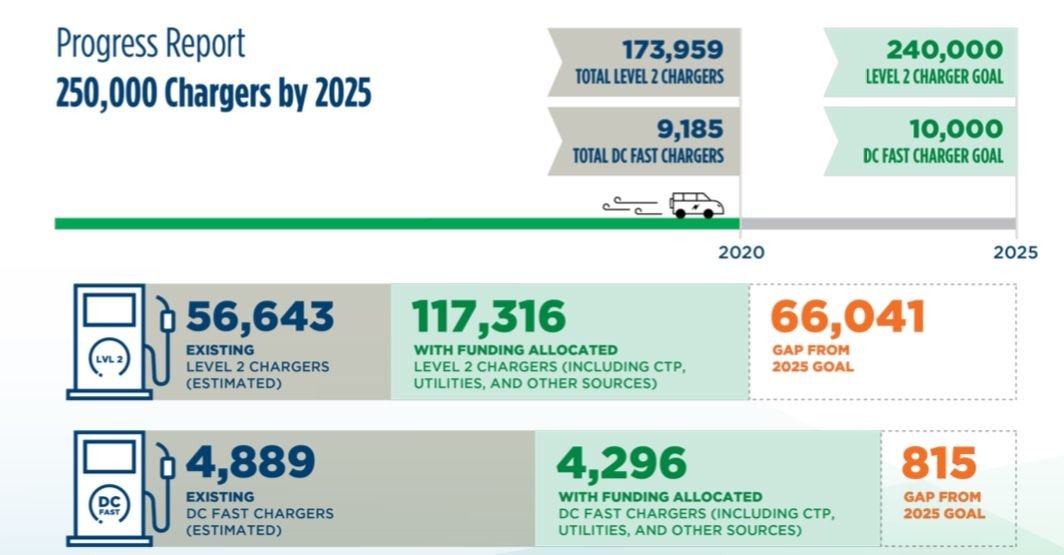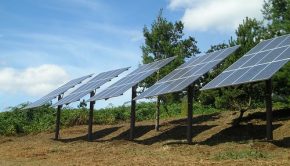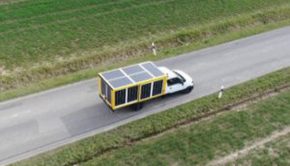California Targets Nearly $400M to Fill Gaps in EV Charging Infrastructure
California Targets Nearly $400M to Fill Gaps in EV Charging Infrastructure
The California Energy Commission is putting a “down payment” of $384 million over the next three years on the electric-vehicle charging and zero-emission vehicle infrastructure needed to meet Governor Gavin Newsom’s pledge to end sales of new gasoline-powered cars by 2035.
CEC’s clean transportation plan released Wednesday (PDF) will direct $133 million for light-duty EV charging systems and another $130 million for infrastructure for zero-emission medium- and heavy-duty vehicles, most of it electric charging.
Another $70 million will go toward hydrogen refueling infrastructure, with $25 million more for “zero- and near-zero carbon fuel production and supply” to meet the need for alternatives to battery-powered vehicles in the decades to come.
This week’s announcement follows on Gov. Newsom’s surprise decision last month, amid record-breaking heat waves and wildfires driven by global warming, to set a 2035 deadline for ending sales of new gasoline-fueled vehicles. That move puts California in the vanguard among U.S. states and in line with more aggressive transportation decarbonization goals being set in European countries including France, the U.K. and the Netherlands.
Transportation accounts for about two-fifths of California’s carbon emissions, and vehicles are harder to decarbonize than electricity generation or using fossil fuels for heating buildings. California’s goal to zero out carbon emissions by 2045 across its entire economy will require massive growth in zero-emission vehicles to reduce that figure.
Of the roughly 26 million automobiles and 6 million trucks registered in California, about 726,000 are ZEVs, according to CEC data, including about 422,000 full EVs, nearly 300,000 plug-in hybrids and about 8,000 fuel-cell vehicles. Current state goals call for 1.5 million by 2025 and 3 million by 2030.
California will also need to add tens of thousands of publicly accessible EV charging systems to provide the electricity drivers and fleet owners will need. “Electric vehicle infrastructure investments are growing at a slower pace compared to trajectories of [plug-in electric vehicle] adoption,” the CEC’s Wednesday report warns.
California has an estimated 57,000 Level 2 chargers and 4,900 direct-current fast chargers today, according to CEC data. Current funding plans from the CEC and utilities are expected to add another 117,000 Level 2 chargers and 4,300 DC fast chargers by 2025 — enough to close in on, but still not reach, the goal of 240,000 Level 2 chargers and 10,000 fast chargers by mid-decade that was set by former Gov. Jerry Brown in 2018.

CEC’s new funding represents a “down payment on electrifying transportation,” Patty Monahan, CEC’s lead commissioner for transportation, said in a statement. But it’s also meant to drive economic development and reduce pollution in low-income and disadvantaged communities, with half of its funds designated for projects in those areas.
The funds are already allocated from state laws passed in 2007 and 2013, making them available for competitive funding solicitations or direct funding agreements over the next three years. The CEC has already invested about $900 million in clean transportation including EV charging and compressed natural gas over the past 13 years, with an additional $880 million in matched funding.
While the new funding levels aren’t tied to specific EV charger deployment targets, CEC’s previous $375 million in electric transportation program funding has brought 11,276 EV chargers to the state to date. That provides a frame of reference for how many could be installed with the new funding, spokesperson Lindsay Buckley said in an email.
California is a hub for EV charging growth for providers like Tesla, ChargePoint, Electrify America, EVgo and other key vendors. California utilities are investing more than $1 billion in charging infrastructure, including the electrical system upgrades and interconnections needed to support EV chargers and incentives for the businesses and institutions that host them.
Southern California Edison won regulator approval this summer to spend $436 million to install 38,000 light-duty EV chargers and $356 million for at least 870 commercial charging stations for medium- and heavy-duty vehicles. Pacific Gas & Electric’s EV charging program will spend $130 million to bring 7,500 Level 2 chargers to its territory over the next few years, and San Diego Gas & Electric’s $100 million program will install about 3,000 medium- and heavy-duty vehicle chargers.
CEC is directing the lion’s share of new funding to EVs since they’re the fastest-growing segment of zero-emission vehicles. Increased development of new EV models and falling prices for batteries are expected to drive costs down to parity with fossil-fueled vehicles by mid-decade.
But vehicles such as semitrucks that need to go long distances will likely need a low-carbon fuel source that can be stored in tanks, rather than in batteries. Fuel-cell-powered vehicles using green hydrogen produced from water and carbon-free electricity could serve as a substitute for fossil fuels, although almost all fuel cells today use natural gas or hydrogen produced from fossil fuels.
Hydrogen fueling has received about $156 million in CEC funding but has seen only 44 fueling stations deployed to date. Another 128 are expected to be built with new funding over the next five years, leaving the state 28 stations shy of its goal of 200 by 2025.









